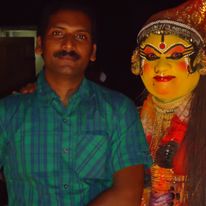Kathakali
Classical dance
Kathakali is a classical dance form that originated in the state of Kerala in southern India. It is a highly stylized and expressive form of dance-drama that combines elements of dance, music, poetry, and acting. The name Kathakali is derived from two Malayalam words, Katha which means story, and ‘Kali, which means play. Thus, Kathakali literally means story-play.
The origins of Kathakali can be traced back to the traditional art forms of Kerala such as Krishnanattam, Ramanattam, and Koodiyattam. These art forms were performed in temples and were based on stories from the Hindu epics such as the Ramayana and the Mahabharata. Kathakali emerged as a distinct art form in the 17th century when it was performed by a group of actors known as the Kalluvazhi.
Kathakali is known for its elaborate costumes, makeup, and intricate hand gestures known as mudras. The costumes are made of colorful silk and cotton fabrics and are adorned with gold and silver ornaments. The makeup is also elaborate and is used to represent different characters such as gods, demons, heroes, and heroines. The makeup is applied using natural dyes and is designed to highlight the facial features of the characters.
Hand gestures or mudras are an important aspect of Kathakali and are used to convey emotions and tell the story. There are over 50 different mudras that are used in Kathakali, each with a specific meaning. The mudras are performed with the fingers and the hands and are accompanied by facial expressions and body movements.
Kathakali performances usually begin with an invocation to the gods and goddesses, followed by a performance of the “pure dance” or the “nritta” which is a sequence of dance movements without any narrative. This is followed by the ‘story dance or the ‘nritya’ which is a sequence of dance movements accompanied by a narrative. The narrative is usually based on stories from the Hindu epics such as the Ramayana, the Mahabharata, and the Bhagavata Purana.
Kathakali performances are accompanied by music which is usually played on traditional instruments such as the Chenda, Maddalam, and cymbals. The music is usually in the form of ragas and talas and is meant to enhance the mood and emotions of the performance.
Kathakali performances are known for their high level of energy and intensity. The actors use their entire bodies to convey emotions and tell the story. They also use their voice to sing songs and recite poetry which is an integral part of the performance.
Kathakali is a highly respected art form in India and is considered to be one of the oldest forms of theater in the world. It has influenced other dance forms such as Bharatanatyam and Mohiniyattam and has been recognized by UNESCO as a “Masterpiece of the Oral and Intangible Heritage of Humanity.
Top 10 Best Kathakali Performances
- Kalyanasougandhikam – This is a popular Kathakali play that tells the story of Lord Krishna’s search for the fragrant flower, Kalyanasougandhikam. The elaborate costumes and makeup of the characters, especially that of Lord Krishna, are breathtaking.
- Nalacharitham – This play tells the story of Nala and Damayanti from the Mahabharata. The performance of the song ‘Moham ennum’ in this play is considered a masterpiece of Kathakali music.
- Duryodhana Vadham – This play depicts the final moments of the villainous Duryodhana from the Mahabharata. The performance of the character Bhima in this play is a marvel to watch.
- Keechakavadham – This play tells the story of the killing of the demon Keechaka by Bhima from the Mahabharata. The makeup and costume of the demon Keechaka are a highlight of this play.
- Kiratham – This play tells the story of Arjuna’s encounter with Lord Shiva in the forest. The performance of the song ‘Ananda nadamaduvar thillai, in this play is considered a masterpiece of Kathakali music.
- Karnaasapatham – This play tells the story of the final battle between Karna and Arjuna from the Mahabharata. The performance of the character Karna in this play is considered one of the best in Kathakali history.
- Rugmangada Charitham – This play tells the story of the king Rugmangada from the Ramayana. The performance of the character Hanuman in this play is considered one of the best in Kathakali history.
- Bali Vadham – This play tells the story of the killing of the demon king Bali by Lord Rama from the Ramayana. The performance of the character Bali in this play is considered a masterpiece of Kathakali acting.
- Kuchelavritham – This play tells the story of Lord Krishna’s meeting with his childhood friend Kuchela. The performance of the song ‘Kuchelavrittam vangapuzha’ in this play is considered a masterpiece of Kathakali music.
- Ravanolbhavam – This play tells the story of the birth of the demon king Ravana from the Ramayana. The performance of the character Ravana in this play is considered one of the best in Kathakali history.
These are just a few of the many outstanding Kathakali performances. Each performance is a visual feast that showcases the skill and artistry of the dancers and actors who bring these stories to life.
Nalacharitham. by Kalamandalam Gopi Undoubtedly, Kalamandalam Gopi is one of the most renowned Kathakali performers of all time. His portrayal of the lead character in ‘Nalacharitham, a story from the Mahabharata, is considered a masterpiece in Kathakali. With his impeccable expressions and graceful movements, Gopi brings the story of Nala and Damayanti to life on stage.
‘Duryodhana Vadham, by Kalamandalam Ramankutty Nair Another legendary Kathakali performer, Kalamandalam Ramankutty Nair’s portrayal of Duryodhana, a character from the Mahabharata, is a classic example of Kathakali’s power to evoke emotions. In ‘Duryodhana Vadham, Nair brings out the complex emotions of the character, from his pride to his vulnerability.
Kiratham, by Kottakkal Chandrasekharan ‘Kiratham, is a story from the Mahabharata about the Pandavas and Lord Shiva. Kottakkal Chandrasekharan’s performance as Arjuna in “Kiratham” is a perfect blend of Kathakali’s grace and vigor. With his powerful movements and mesmerizing expressions, Chandrasekharan captures the essence of the story and the character.
‘Kalyanasougandhikam, by Kalamandalam Krishnan Nair ‘Kalyanasougandhikam, is a romantic story from the Mahabharata. Kalamandalam Krishnan Nair’s portrayal of the lead character, Bheeman, is a beautiful example of Kathakali’s ability to convey emotions through facial expressions and gestures. With his subtle movements and delicate expressions, Nair brings out the love and longing of the character.
‘Karna Sapa Vimochanam, by Kalamandalam Padmanabhan Nair ‘Karna Sapa Vimochanam, is a story from the Mahabharata about Karna, one of its most complex characters. Kalamandalam Padmanabhan Nair’s portrayal of Karna in this performance is a testament to his mastery of the art form. With his powerful movements and subtle expressions, Nair brings out the conflicting emotions of the character, from his loyalty to his mother to his sense of duty.
Abhishekam, by Kalamandalam Sivan Namboodiri ‘Abhishekam, is a story from the Ramayana about Lord Rama’s coronation. Kalamandalam Sivan Namboodiri’s portrayal of Lord Rama in this performance is a beautiful example of Kathakali’s grace and elegance. With his delicate movements and serene expressions, Namboodiri captures the divine nature of the character.
‘Kuchelavrutham, by Kalamandalam Gopi ‘Kuchelavrutham, is a story from the Bhagavata Purana about Lord Krishna and his childhood friend, Kuchela. Kalamandalam Gopi’s performance as Lord Krishna in this production is a beautiful example of Kathakali’s ability to…!!
Santhosh Cab in Kerala taxi and Tempo traveler rental

